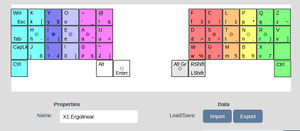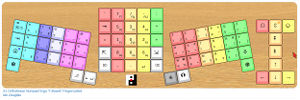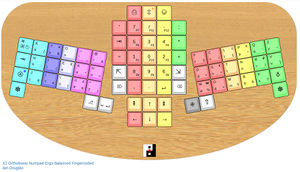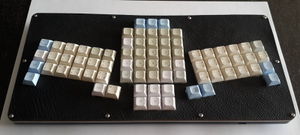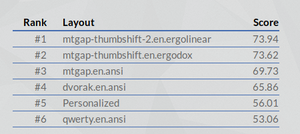Ergolinear
The Ergolinear layout is a proposed layout that puts into practice lessons learnt while evaluating numerous logical layouts with Patrick Gillespie's Keyboard Layout Analyzer. The name is a simple portmanteau of "ergonomic" and "ortholinear".
Background
During 2016, Ian Douglas started to collaborate with Xay Voong, developer of the BEAKL line of logical layouts, in trying to develop the optimal keyboard layout for English. While Xay made use of AdNW's "opt" analyzer, both parties compared results using Patrick Gillespie's Keyboard Layout Analyzer (KLA).
It soon became apparent that certain features in layout design affected the score:
- Layouts which put things on an AltGr layer, like Arensito, had an advantage due to reduced finger travel, and better use of thumbs.
- Layouts which were ortholinear in style, like Ergodox, had an advantage due to reduced finger travel.
- Avoiding wide keys produced an advantage, due to reduced finger travel.
- Replacing two shift keys operated by the pinkies, with one shift key operated by the thumb, produced a big improvement in the score.
- In general, reducing pinky load and distance helped a lot.
At the same time, it became apparent that while the Ergodox layout provided many of these features, the large vertical keys, and many thumb keys, was not the optimal design.
Development
Taking these factors into account, Ian started playing around with ideas, which led to this conceptual layout:
This mockup shows only the keys needed for KLA.
Some of the features of this approach, compared to other similar compact ergonomic designs:
- All keys are the same size, 1U.
- There is only one space key, on the left thumb.
- The Enter key is accessed via AltGr-space.
- The right thumb rests on the AltGr key. In other versions, it may be on the shift key.
- There is one shift key, operated by the thumb.
- Punctuation and digits are accessed via AltGr.
This prototype was used to develop high-scoring layouts on KLA.
Translating to the real world
The prototype shown above can be extended for use in the real world.
The initial layout, based very much on ANSI, but with a central numpad, was known as the I-Board, and looks like this:
This was later refined to look like this:
The initial prototype of this form factor is under construction, and looks like this:
Performance
We compare three versions of the MTGap layout, using Chapter One of "Alice in Wonderland," on KLA:
If we use the same three layouts, and compare using Den's revised scoring, which includes vertical distance, and measures effort, so that lower is better, we get:
As can be seen, the Ergolinear format produces better scores compared to the Ergodox or ANSI variants.
